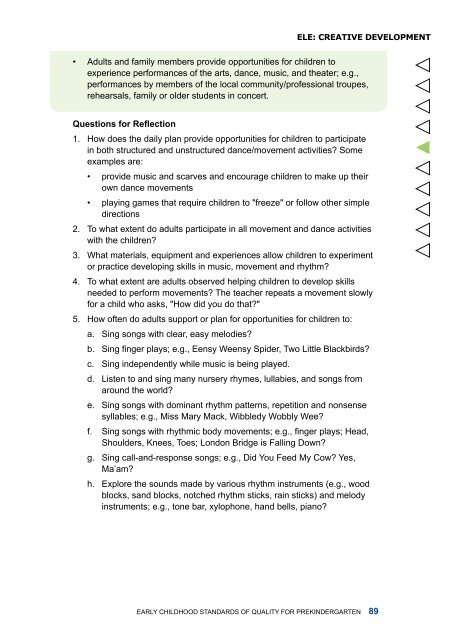Early Childhood Standards of Quality for ... - State of Michigan
Early Childhood Standards of Quality for ... - State of Michigan
Early Childhood Standards of Quality for ... - State of Michigan
You also want an ePaper? Increase the reach of your titles
YUMPU automatically turns print PDFs into web optimized ePapers that Google loves.
ELE: Creative Development• Adults and family members provide opportunities <strong>for</strong> children toexperience per<strong>for</strong>mances <strong>of</strong> the arts, dance, music, and theater; e.g.,per<strong>for</strong>mances by members <strong>of</strong> the local community/pr<strong>of</strong>essional troupes,rehearsals, family or older students in concert.Questions <strong>for</strong> Reflection1. How does the daily plan provide opportunities <strong>for</strong> children to participatein both structured and unstructured dance/movement activities? Someexamples are:• provide music and scarves and encourage children to make up theirown dance movements• playing games that require children to "freeze" or follow other simpledirections2. To what extent do adults participate in all movement and dance activitieswith the children?3. What materials, equipment and experiences allow children to experimentor practice developing skills in music, movement and rhythm?4. To what extent are adults observed helping children to develop skillsneeded to per<strong>for</strong>m movements? The teacher repeats a movement slowly<strong>for</strong> a child who asks, "How did you do that?"5. How <strong>of</strong>ten do adults support or plan <strong>for</strong> opportunities <strong>for</strong> children to:a. Sing songs with clear, easy melodies?b. Sing finger plays; e.g., Eensy Weensy Spider, Two Little Blackbirds?c. Sing independently while music is being played.d. Listen to and sing many nursery rhymes, lullabies, and songs fromaround the world?e. Sing songs with dominant rhythm patterns, repetition and nonsensesyllables; e.g., Miss Mary Mack, Wibbledy Wobbly Wee?f. Sing songs with rhythmic body movements; e.g., finger plays; Head,Shoulders, Knees, Toes; London Bridge is Falling Down?g. Sing call-and-response songs; e.g., Did You Feed My Cow? Yes,Ma’am?h. Explore the sounds made by various rhythm instruments (e.g., woodblocks, sand blocks, notched rhythm sticks, rain sticks) and melodyinstruments; e.g., tone bar, xylophone, hand bells, piano?<strong>Early</strong> <strong>Childhood</strong> <strong>Standards</strong> <strong>of</strong> <strong>Quality</strong> <strong>for</strong> Prekindergarten 89


